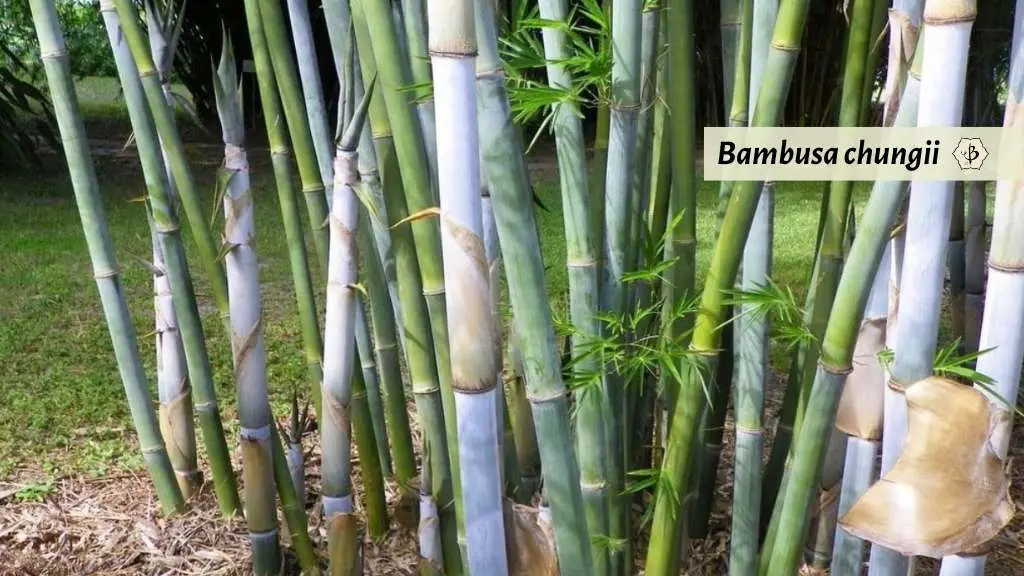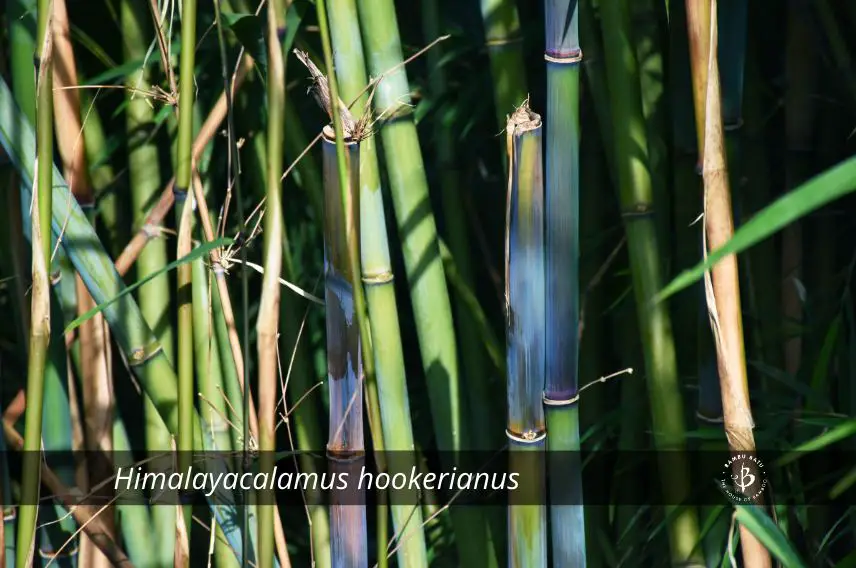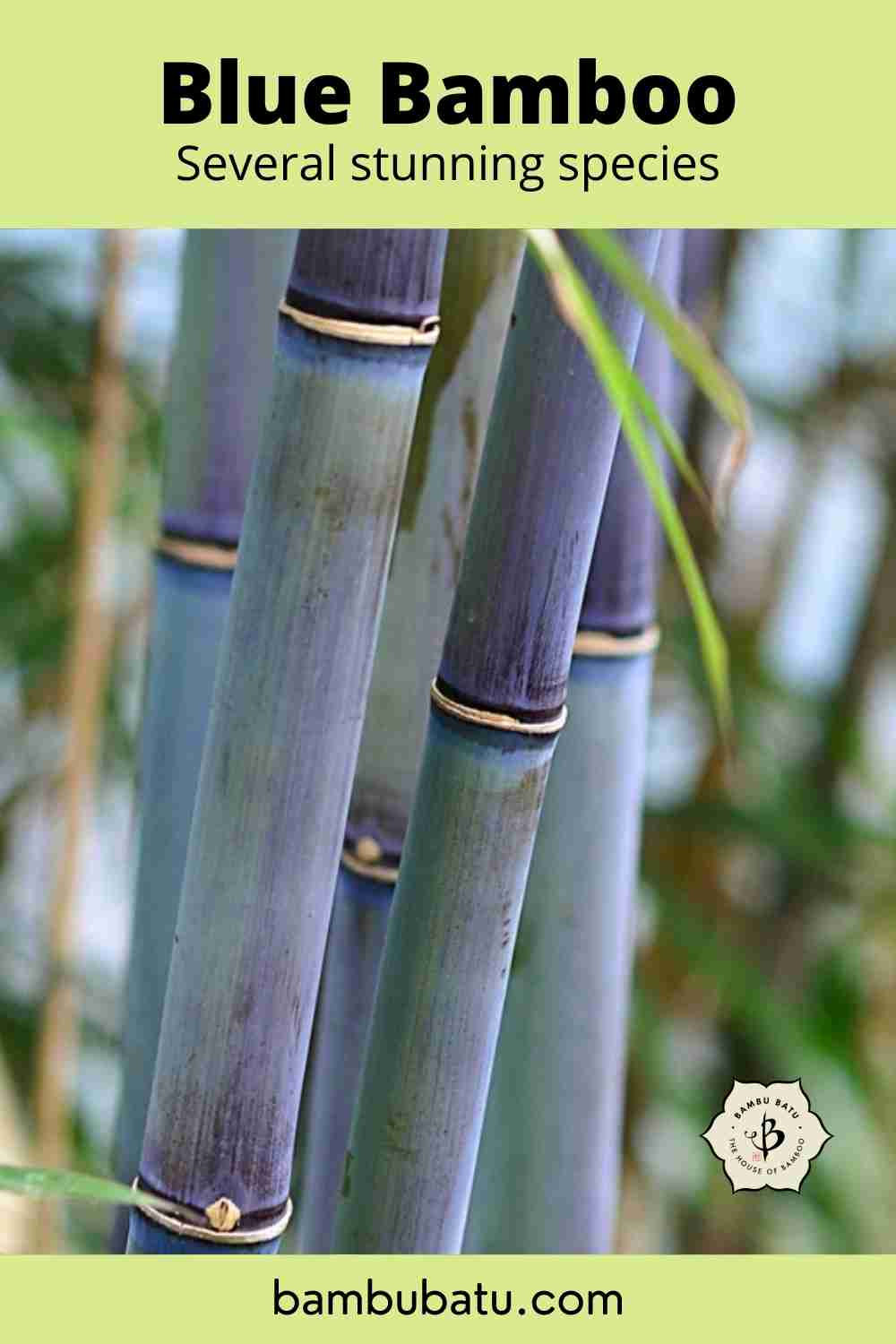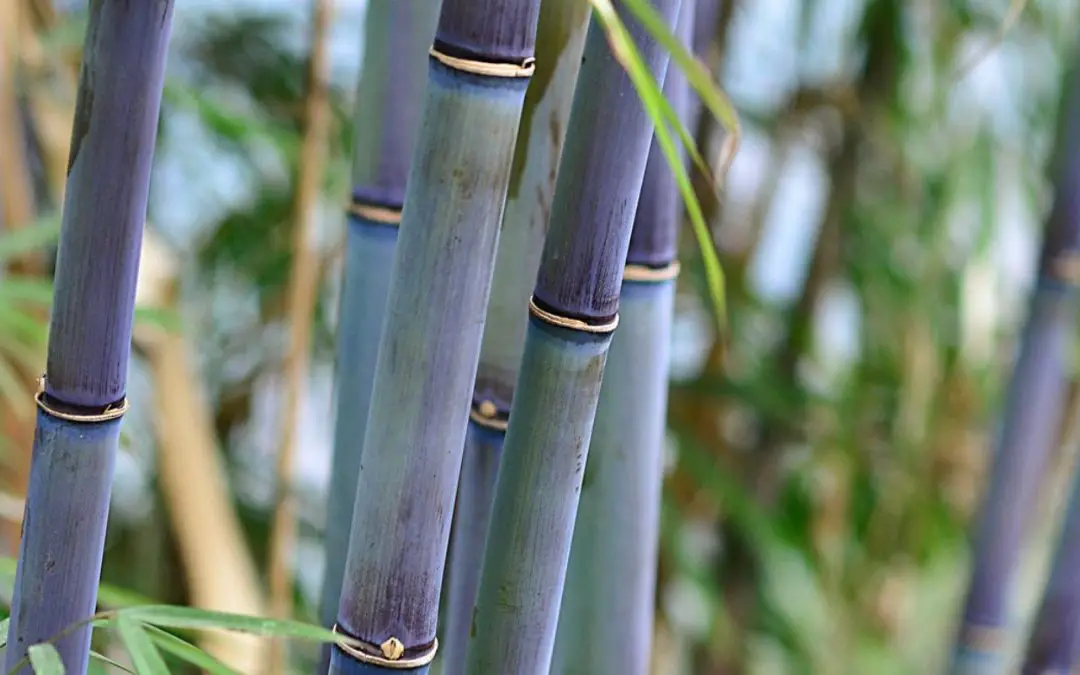So you have enough green bamboo, golden bamboo and even black bamboo. Now you’re ready to branch out into the far reaches of the rainbow. Pardon the mixed metaphor, but maybe it’s time for you to plant some Blue Bamboo. Is that even a thing? And if so, what is it?
Bambusa chungii, a tropical clumping variety, is the species most commonly referred to as Blue Bamboo. Himalayacalamus hookerianus, a temperate clumper, also goes by the name Himalayan Blue Bamboo. Other species of Himalayacalamus as well as the closely related genus Drepanostachyum sometimes display this unusual property too. These varieties are somewhat rare but exceedingly attractive in ornamental landscaping. The striking color results from a light, powdery substance with a waxy texture that is present on new culms. The coloration tends to change throughout the course of the year, with older culms gradually looking less blue as the protective powder dissipates.
Bamboo Genera
This article is part of an ongoing series about different species and genera of bamboo. To learn more about this fascinating collection of grasses, check out some of these useful and informative articles.
- Introducing bamboo: Genus by genus
- Clumping bamboo
- Genus Guadua: Giant neo-tropical bamboo
- Genus Fargesia: Clumping bamboo for cold climates
- Running bamboo
- Genus Chimonobambusa
- Genus Phyllostachys
- Herbaceous bamboo: Olyreae
Characteristics of Blue Bamboo
It’s not hard to recognize a bamboo plant when you see one, but it can be difficult to imagine just how much diversity there is within this subfamily of the Poaceae (grass) family. Some giant varieties can get more than 100 feet tall, while others grow no larger than a chopstick. One bamboo prefers the hot jungles of Madagascar, another the cool slopes of the Himalayas, and another the equatorial highlands of Colombia. Some have stalks that are shiny black, while others are buttery yellow or emerald green. Some have culms that arch gracefully, others that bulge exotically, and some that are blue.
How blue is blue?
Just how blue is a blue bamboo? Well, don’t expect to see a row of bright, royal blue canes. But you can count on some brilliant blue highlights. The feature is far more prevalent on the fresher, younger culms, with a tendency to fade over time, turning more green or more yellow, depending on the species. Generally, the blue combines with the more common shades of green to produce something of an emerald green aspect. Sometimes the blue influence is stronger, and the result is more of a turquoise hue. You can argue back and forth over how much blue you get, but these distinctive bamboo varieties are undeniably beautiful.
What makes them blue?
The blue tint in these species doesn’t actually grow in the fibers of the plant itself. As a matter of fact, it comes from a white, powdery substance that makes the culms waxy to the touch and provides a kind of protection against moisture. The powder appears on new shoots, probably to protect them from mold or mildew that might otherwise occur in the wet growing season.
Against the bright green of the new culms, the white powder alters the appearance so that they take on various shades of greenish or grayish blue. As the new shoot grows, the powder thins and scatters, the effect diminishes and coloration fades.

Species of Blue Bamboo
Several species may go by the name “Blue Bamboo”, and some will be more common than others depending on your climate. Bambusa is a tropical genus, and those varieties will not tolerate prolonged freezing. Himalayacalamus and Drepanostachyum varieties are native to the Himalayas, so they are quite cold hardy, but don’t do well is especially hot climates. With that in mind, it shouldn’t be difficult to decide which species are best suited for your garden.
Bambusa chungii, Tropical blue bamboo
This medium-sized species, also called Tropical Blue Bamboo, is one of the most highly sought-after bamboos in tropical areas. They do especially well in Florida, Southern California and Hawaii, but high demand makes them difficult to source. Growing about 30-40 feet tall, the 1.5-2 inch thick culms come up a powdery blue color and gradually turn a deep blue-green or emerald. Tight clumps make for a stunning specimen plant, but they can also serve as an attractive privacy screen when planted together in a row. Happiest in sub-tropical settings, but they’re adaptable to more climates, cold hardy to about 20º F.
Bambusa chungii ‘Barabrella’, Barbie
The slightly shorter and more compact subspecies is very similar to B. chungii in appearance and color. It is also very popular as an ornamental due to its tight footprint, which is about 5 or 6 feet wide.
Borinda papyrifera, Blue Dragon
Sometimes listed as Fargesia papyrifera, this exotic clumping bamboo is native to the high elevations of Southern China and the Himalayas. In good conditions, it can grow up to 15 or 20 feet tall with culm up to 2 inches thick. Powdery blue culms are beautiful in appearance, complemented by vibrant green leaves. An excellent choice in cool climates and in shady areas, this species is not as cold-tolerant as other Fargesias, but still hardy well below 0º F.
Also see our featured article on Borinda fungosa: Chocolate Bamboo.
Himalayacalamus hookerianus, Himalayan blue bamboo
This is one of the most popular and widely available species of Himalayacalamus. Himalayan Blue typically grows about 15 to 20 feet tall, with narrow culms, 3/4 to 1 inch thick. Young canes have a powdery blue color. Sometimes they turn turquoise, highlighted by white rings around the nodes. As they age, the canes turn more olive green and then golden yellow. If one side gets more direct sunlight it could take on a reddish hue. Himalayacalamus species also have leaves that are thin and wispy, adding to their graceful, attractive appearance. Mature clumps are about 10 feet in diameter. Not suitable for hot and humid climates, they prefer high altitudes and/or shady, filtered sunlight. Cold hardy down to about 15º F.
This species originally comes from Bhutan, Nepal and northeastern India. It has also been called Drepanostachyum falcatum. You might also find subspecies listed as ‘Baby Blue’ and ‘Teague’s Blue’.

Himalayacalamus porcatus, Nepalese blue
This species is very similar to the Himalayan Blue, but considerably smaller and more compact. Grayish white to light blue culms grow about 6 to 10 feet tall, and 1/2 to 1 inch thick. Mature clumps are about 3 to 4 feet wide. The plant can be pruned to be even smaller and looks great in a pot or container. Culms of this species also tend to arch a bit more than their upright cousins. Like all Himalayacalamus, Nepalese Blue does much better in cooler climates with limited direct sunlight. Hardy to about 15º F without frost damage.
Drepanostachyum khasianum, Purple jade bamboo
This genus is closely related and often mistaken with Himalayacalamus. The main difference is in the branching, where Drepanostachyum has many equally sized branches at each node, and Himalayacalamus has one dominant branch. Native to the highlands of northern India, this is an especially attractive and exotic species. New shoots have a burgundy hue, and the white powder gives them a blueish and sometimes purple tint. Over time they fade to orange-yellow. Culms are slender and elegant, growing 10-20 feet tall. Nodes can be very pronounced, with a white ring that makes them stand out. Ideal in cooler climates or a shady setting. Also does well in pots.
Further reading
If you enjoyed reading about blue bamboo, you might also be interested in some of these other exotic bamboo varieties.
- Rare bamboo species
- Tropical bamboo for warm climates
- Clumping bamboo for cold climates
- Bamboo with stripes
- Zigzag bamboo
FEATURED IMAGE: Drepanostachyum khasianum in full color



























Ordered Bamboo to promote climate change in inner city of Delaware State
The Blue Bamboo I am confident that it will grow in this region.
Sounds like a great project, Jammie. Himilayacalamus might do OK in Delaware. Phyllostachys glauca is probably even more suitable. Check out our articles about cold-hardy bamboo for snowy climates.
I’m in East Texas and wanting something more compact but wanting to grow it in a row making a trellis type square.What do you suggest ?
You can do that with Blue Chungii, if frost is rare in your area. Bambusa textilis also makes a great hedge.